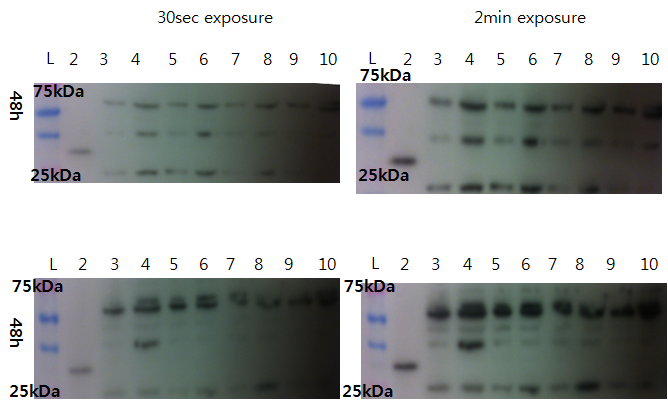Contents |
CHO Transfection with LovTAP only
Protocol: Transfection of CHO cells
This is the transfection protocol used at the LBTC lab for CHO DG44 cells. The transfection reagent is PEI ([http://en.wikipedia.org/wiki/Polyethylenimine polyethylenimine]).
Please use the provided Excel sheet to calculate the volume of plasmid you should add to the cells. Replace every value in red by your own, then print the sheet out and follow the provided protocol.
1. Passage seed 1 day prior to transfection.
2. Prepare tubes (yellow caps with holes) by addition of the calculated amount of DNA.
3. Centrifuge the necessary volume of seed (after a PCV measurement), remove conditioned medium with the pump (use a 2 ml serological pipet with a broken neck) and resuspend (first in 10 ml) in necessary volume of fresh medium to achieve the required cell density (3 mio/ml).
4. Add 5 mL of the cell suspension to the tube with DNA and mix orbitally.
5. Add the PEI (45 µl) to the Cell+DNA mixture as soon as possible, flick 3 times.
6. Place in the incubator at 37°C.
We trasfected a batch of CHO cells with LovTAP only. We made two tubes with 100% LovTAP and one with 95% LovTAP and 5% pOri-eGFP (this is a control plasmid with a very high constitutive expression of GFP, it is used to check if the transfection has worked, with the Guava).
Guava Measurements on HEK cells transfected with pHY42 and a GFP readout
Protocol: Fluorescence (Guava)
Prepare your samples by measuring their PCV (or estimating the cell amount according to the doubling rate). Dilute them with PBS in order to have between 200 and 500 cells/µl. Prepare at least one well that has seed cells.
Steps 1 to 4 are optional and should be done from time to time.
1. Trash the waste on the bottom right of the machine if it is full before you start.
2. Put tubes with bleach (detergent) at the right positions.
3. Run 'Cytosoft 5.3'
4. Click Clean and Shut Down -> This would take around 15 min.
5. After cleaning, click Guava Express Plus on the left column.
6. Go to Analysis mode and click 'Open Data Set'.
7. Go to the 'iGEM' folder and open the 'Setting' file.
8. Go to Acquisition - and hold here.
9. Go to the desktop and run WorkEdit 5.3.
10. Highlight the wells you are going to use, check "Acquire this sample".
11. Label them as Guava Express Plus, check the "Mix for 3 seconds", set the speed from high to medium. Optionally, fill the sample ID and the dilution factor.
12. Save and go back to Cytosoft 5.3.
13. Go to Acquisition, start the worklist.
14. Place the 96-well plate into the tray, make sure the A1 well is where it should be.
15. Name the file as 'Today's date_title'
16. When you are asked to adjust the settings, check a well that contains seed cells.
17. Compare with the worklist, check if the flow and the amount of cells detected are reasonable.
18. Click "Next step" and then "Resume".
19. Wait until all the wells are measured - data will be saved automatically.
20. Take the 96-well plate out and insert the tubes that are required for cleaning.
21. Go to Main menu and click 'Clean and shut down'.
A routine measurement of green fluorescence has been performed on the HEK cells transfected with melanopsin. We didn't see a big difference of GFP expression between transfected and non-transfected cells. However, we can notice that the cells that have been under the Arduino blue light for a while have a different shape and less viability.
 "
"
